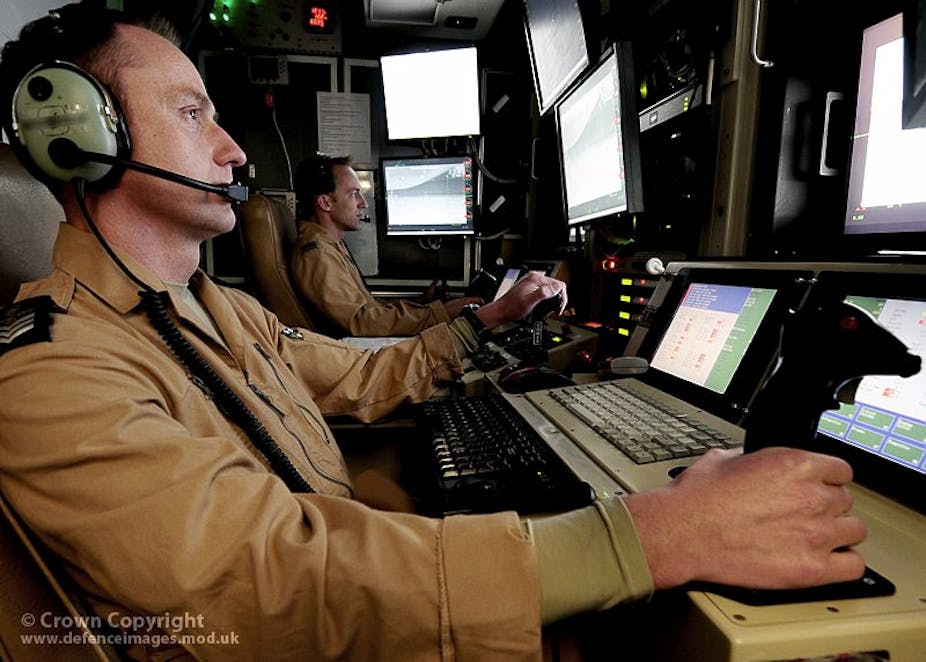The Reaper drone pilot and sensor operator stared intently at the bank of screens in front of them, their concentration fixed on one individual. Their target had been identified by more than one intelligence source and extended observation had confirmed both his identity and activities as a Taliban fighter. The mission intelligence co-ordinator continued to provide them with checks and updates, while legal sanction to attack the target had been granted.
As the selected weapon was about to be released and the target killed several thousand miles away in Afghanistan, the RAF sensor operator thought he glimpsed, fleetingly, what may have been another person encroaching onto the camera’s field of vision. The pilot had seen nothing untoward.
A discussion ensued: there might have been someone there. But they were cleared to fire and their rules of engagement allowed them to do so. With the crew split over what they did or did not see, given even the small possibility of killing or maiming an innocent passer-by, they agreed to abort the attack.
Contrary to popular mythology, the crew members involved in this real-life incident were not itching to pull the trigger in the latest deadly round of “death by Playstation”. Such caution challenges many ill-informed and oft-repeated assumptions about RAF Reaper drone operations: the crew’s concerns prompted by a complex interplay of rules of engagement, commander’s intent, and a desire to act ethically at the extreme of human activity – killing another human.
One sensor operator summed up these three considerations like this: “Keeping the lawyers happy, the boss happy, and letting me sleep at night.”
Convenient killing?
Anti-drone campaigners and critics of the military use of remotely piloted aircraft rely on three key arguments: drones are somehow depersonalised and make killing “easy”; they encourage politicians to use force knowing that no aircrew lives are at risk; and they conflate legitimate military activities with the morally and legally dubious actions of the CIA in Pakistan, Somalia and Yemen. All underpinned by Hollywood-fuelled fears of unthinking, autonomous killer robots.
So in what way is killing made “easy”? Technically, killing – or even just conducting surveillance – by Reaper is extremely difficult. Hundreds of specialists are needed: from software writers to airframe technicians, electronics engineers to communications experts, armourers to logisticians, intelligence coordinators to legal advisors, and so on.
Some opponents claim that targets have become dehumanised blips on screens. Minimal evidence and maximal hyperbole is invoked: all without speaking to the operators involved or understanding the personal familiarity and empathy that results from hours and days of fine-detailed observation.
In the course of my research, one pilot described his experience to me thus:
I have killed the enemy from both [conventional aircraft] and from the Reaper [drone]. The body’s reactions are the same – it surprised me. Your mouth goes dry and the hairs on the back of your neck stand up. Everything goes tense and you get that sick feeling in your stomach. You know what you are about to do.
Hardly killing made easy. And nobody yet fully understands why PTSD rates among UK and US Reaper crews are similar to the rates found in manned aircraft pilots.
Perhaps “easy” refers to the sheer numbers that can be killed using a particular weapon? If so, then the B-52 bomber should top the hate-list. Or not. In the grotesque calculus of death, nearly a million people were brutally murdered in Rwanda in only a few weeks in 1994. Yet nobody campaigns to ban the household knives, machetes or farming tools that were used to commit mass slaughter.
Use them wisely
There can be little doubt there is a temptation for politicians to use drones for apparently low-cost military intervention. But if it is that simple why were Reapers and Predators not dispatched to Syria months or years ago? Because they are slow and vulnerable and would not last five minutes against Syrian or any other competent air defences. In any case, a lack of drones never stopped powerful countries from interfering across borders in the past.
States that have already acquired lethal, remotely piloted aircraft have at least a moral responsibility to use the technology wisely. As a result of CIA actions, the US is creating generations of enemies in some regions of Pakistan – and perhaps at home as well – for no discernible strategic advantage.
The toxic combination of the abuse of technology for political ends and the fomenting of hysteria in opposition to the use of drones could result in numerous benefits being lost. From the UN’s deployment of drones to observe rebel groups in DR Congo to their use fighting recent Australian bush fires, and from anti-piracy activities to the monitoring of endangered animals and vulnerable refugees, remotely piloted drones offer many advantages. The myth of “easy” killing is just that: a myth.

